Polarion ALM 20 R2 – What’s New and Noteworthy

A new major version of Polarion is available – Polarion ALM 20 R2.
In this release, we deliver some significant new features as well as improvements and enhancements to existing functionality, based on feedback from our customers who use our solutions every day. The release also includes ongoing quality and performance improvements.
These new features figure prominently in release 20 R2:
- Further Improvements to Collections
- Now supports adding documents to Collections from other projects.
- Collection enabled search
- Provides the ability to create Baselines for Collections
- Reuse (include & duplicate operations)
- Landscape orientation respect and support in LiveDoc documents and Word Roundtrip – This enhancement provides support for Landscape page orientation with import and round-trip for Microsoft Word.
Major enhancements include:
- Reuse Work Items within LiveDocs including attributes – Copy & paste of Work Items within LiveDocs provides a possibility to copy also all custom field and built-in field values.
- Electronic Signatures integrated with single sign-on – Electronic signatures can rely on an authentication token from your identity provider.
- Ordering enumerations by drag & drop – Provides much easier sorting of enumeration lists in administration.
So let’s dive deeper into what’s new in the release.
Further improvements to Collections
For Polarion 20 R2, we have introduced further improvements to Collections. If you recall, Collections provide an easy way of creating sets of Document revisions (or a baseline), where the same Document revision can be reused in multiple collections if desired. When used in this manner, Collections are appropriate for audit and regulatory compliance needs.
Collections can also be used to work inside of a mix of current Documents and revisions or baselines. Collections allow you to remain within a context and make it easy to create links between Document and Work Item revisions. When the work is complete on the current Collection, it can be closed and frozen. When used in this manner, Collections are appropriate to support parallel or concurrent development activities within the V-lifecycle.
Adding documents to collections from other projects
It’s now possible to add Documents to your Collections from other projects. This is particularly useful if you have portioned your work products into other project areas and now need to consume those deliverables in your current project. You will notice as you browse the Collection Documents that include other project Documents that the navigation sidebar indicates which project area the Document originates from. This helps you track of where Documents originated while navigating and traversing the contents of a Collection
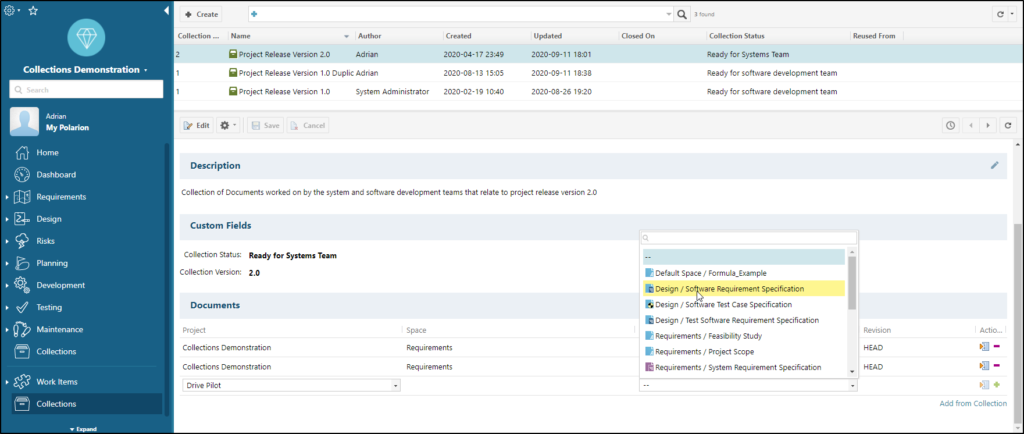
Collection enabled Search
Both global search and search within Collections are now supported. This means, for example, that you can quickly find the Collections you are looking for or drill down to find which Collections contain specific Documents. In the global search, a new Collection section appears, making it very clear to you which Collections are relevant to the search query.
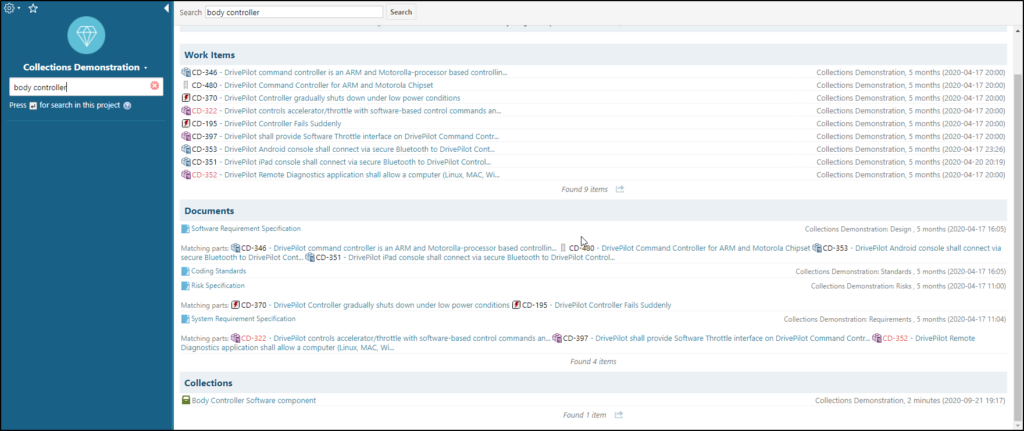
Support Baselines for Collections
The Collection capability was further improved to support Baselines. Like the concept of Document Baselines, a Collection can now be baselined where its current state is a snapshot. When a Collection is baselined, it remains in an open state where you can continue working. You may go back and look at earlier baselines of a Collection using the History view. There you will quickly see all the Baselines associated with the Collection, and you can open any of them as needed. You can still choose to close the Collection at any time.
To clarify whether you are looking at a Collection Baseline or a Document that is contained in a Document Baseline, graphical identifiers have been added to the navigation sidebar as well as the main Collection window.

Collection Reuse
The Collection capability was further refined to support multiple reuse scenarios. Firstly, while working inside a Collection, it is possible to include all the Documents that exist in another closed or baselined Collection. You can pick Collections that exist in other Projects too. This means that if you need to reuse the contents of a complete Collection, you can do so quickly and in one operation rather than having to manually add the Documents and choose the revisions or Baselines.
In addition, it’s also possible to reuse a Collection and duplicate it in its entirety. Polarion will recreate any custom fields you have associated with the Collection automatically. You can choose to reuse a Baseline, a revision, or a head Collection. If you reuse a Collection at its head, any head Documents will be duplicated in their current revision state, since currently, only one head Document can exist in one Collection. You are free to reuse Collections even if the Documents contained in the Collection exist in other Polarion projects. The resulting reused Collection will be in its open state, where you will be able to add/delete additional Documents, modify the custom fields, or do any additional changes just as if you had created the Collection from the start.

Landscape page orientation in LiveDocs
We have made some updates to our Microsoft Word Import and Round-trip capability. Now we respect page orientation formatting. So, if you have Word documents oriented portrait only, landscape only, or a mix of portrait and landscape, these are imported into Polarion with the orientation respected. You will also notice that when viewing LiveDoc documents, we updated the rendering of page breaks. In addition, there are visual identifier icons on the page breaks representing the page orientation (portrait or landscape). You can add or change page orientation in the Document Editor. When Documents are exported or round-tripped back to Microsoft Word, the page orientation is also maintained.
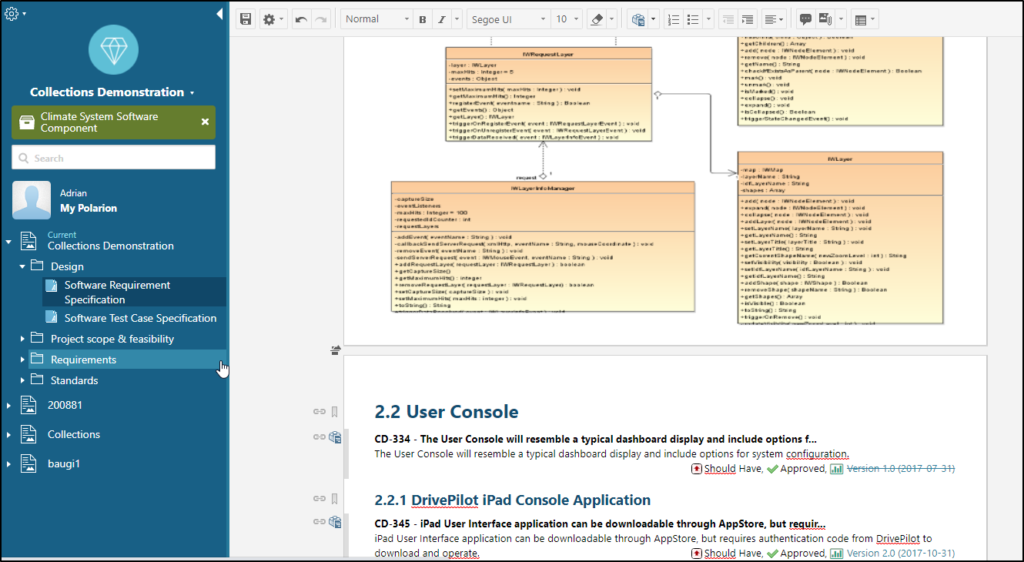
Other Enhancements
Reuse Work Items including attributes via copy&paste
The Work Item reuse when copying & pasting a Work Item within the same LiveDoc document was improved to copy all attributes. So it is now much easier to split requirements into multiple ones, or duplicate requirements that are similar to others. Similar to the cross-document copy & paste, this scenario within one document provides you with more options to duplicate only Basic content or to copy additional attributes and custom fields. You can link the newly created Work Item to the original one too.
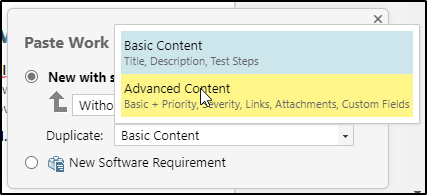
Updated Highcharts to new version
Polarion leverages a popular charting library Highcharts. Upgrading it to the newest version brings a number of benefits:
- More charts are available, e.g. histogram, sunburst, timeline, network graph, Venn diagram, or org chart.
- Charts intelligently recognize the boundaries for the Y-axis. (Starting at 0 for charts that display counts.)
- Hovering over the series label highlights the specific series for better readability.
- PDF export displays the charts in vector format, which results in sharper and crisper chart output at any scale.
If you create your own useful chart widgets, consider sharing them with the Polarion community on our Polarion Extension Portal.
Security and Authentication Enhancements
Authentication with OAuth 2.0
Polarion authentication has been extended to support the OAuth 2.0 protocol. We were aiming for a very generic configuration that, in theory, should support any identity provider. The most popular providers such as Auth0, Google, Facebook, Github, or Microsoft Azure were tested.
Similar to the SAML provider, it is possible to configure a mapping, so that user attributes are automatically updated from the identity provider upon login in order to keep your users’ data up to date.
Electronic signatures integrated with single sign-on authentication
Using electronic signatures together with single sign-on authentication required an additional LDAP connection to your identity provider – until now. To simplify the configuration and address limitations for cloud identity providers such as Okta, Polarion 20 R2 can leverage single sign-on authentication source to validate the signature.
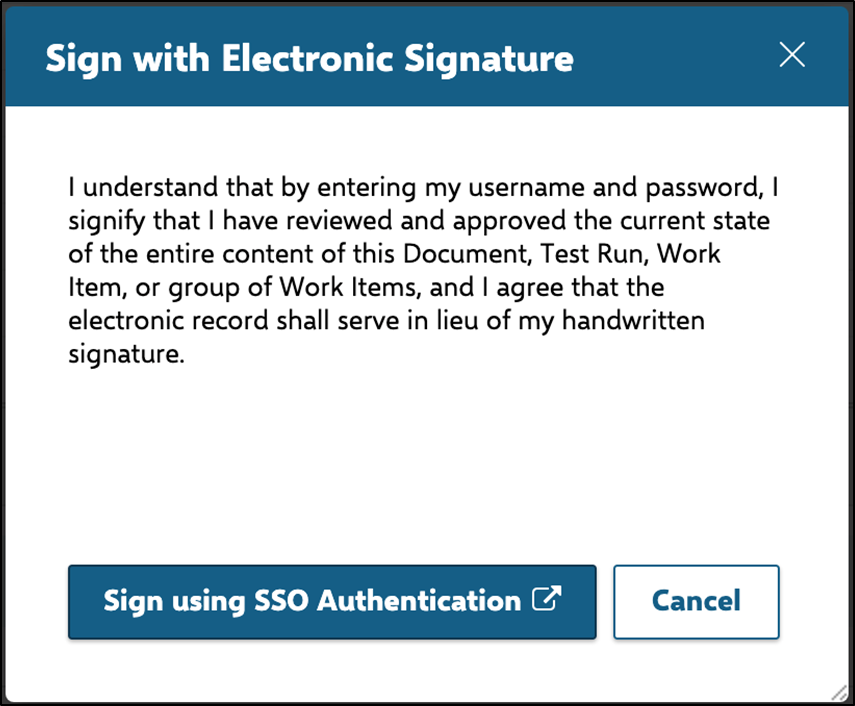
Additionally, leveraging the identity provider to authenticate the signature makes it possible to use more tokens than just credentials. (For example, PKI cards, or two-factor authentication via a mobile authenticator app!)
Nested groups support in LDAP authentication and synchronization
Our documentation for LDAP integration was extended with a detailed guide on how to use the nested LDAP groups in the authentication and synchronization via the LDAP directive LDAP_MATCHING_RULE_IN_CHAIN. Note that this configuration also works on older Polarion versions.
Usability Enhancements
Sort enumerations via drag & drop
Organizing enumeration options has never been easier with the new drag & drop feature that allows you to re-order the items quickly!

Easy handling of big images and diagrams in rich-text
To simplify the polishing of Documents, if you insert a big image or diagram that would overflow the document boundary, Polarion now automatically shrinks the image to fit the Document width. The Image preview dialog now also lets you zoom in on big images to see the full details of a shrunken image in both LiveDocs and Rich Text Fields.
Multi-select support in additional dialogs
In the Document editor and on Rich Pages, additional dialogs provide multi-selection via CTRL+click and SHIFT+click to simplify views configuration. (Examples include the Fields selector in the Work Item Properties sidebar, the Parameter selector, and more.)
Look and Feel alignment of read-only views
Several other views that were not recolored in the previous 20 R1 release have been adjusted to match the Siemens standard and the rest of the Polarion UI. These include the delegated Work Item detail dialogs that appear for OSLC, print dialog, or e-mail notifications.
Connector Enhancements
Commit traceability with Bitbucket Server
Completing the list of the supported repository providers for source-code change traceability, we added support for connecting to repositories hosted on an on-premise Bitbucket Server.
Jira Connector updated to support new APIs
The Polarion to Jira connector was adjusted to reflect the latest changes in the Jira Cloud APIs, mostly related to the user management and GDPR.
Easier tracking of Jenkins build trigger
The newly introduced Jenkins connector was enhanced to display information about the trigger of the build. You can now easily track if the build was triggered manually, via a scheduled job, or from a workflow action.
Mendix connector for Polarion
A new Mendix connector for Polarion allows you to quickly create a customized UI for Polarion with Mendix. The connector provides a set of easy-to-use interfaces in Mendix to integrate Polarion data and events into your own Mendix Apps, so you can integrate data from multiple sources and streamline specific use cases in one view.

Performance and Scalability
Our development teams are steadily working on improving Polarion’s performance and scalability and the 20 R2 version has improvements in a number of areas.
Adjusted tree view behavior
The creation of a traceability view in Polarion can be a resource-heavy operation. (One that might calculate the tree from hundreds of thousands of Work Items.) To limit the impact of single user operation on the entire system, we reworked the limit handling in the Work Items Tree. Now tree rendering will be stopped after going through 20,000 Work Items and users are given a chance to review the configuration to get the right view and prevent an excessive allocation of server resources.
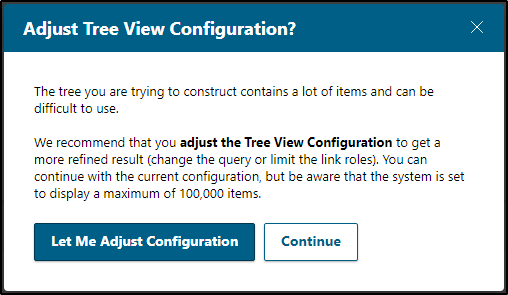
Faster opening and saving of LiveDocs
Do you use Wiki Content blocks in your LiveDoc documents? Then you will love to learn that the opening of these LiveDocs was significantly improved, based on the complexity of your report content. Data from our customers show a 50 to 80% speedup and this does not apply to only LiveDocs, but also to the legacy Wiki reports.
This was not the only improvement for LiveDocs. Saving multiple comments during the review process was improved by an average of 25%.
Excel import and export
Another operation that we focused on was Excel import and export. Our tests on real customer documents show an average 55% speedup for imports and a 90% speedup for export operations.
Historical indexing speedup
Historical indexing literally goes through all the data in your Polarion instance, so It can take quite a bit of time. We are half-way through a project to bring a significant performance boost, but the first results are already visible in the 20 R2 version. The improvement depends on the data, but our test repositories show an average improvement of 25% on total history indexing time, while the biggest boost (up to 80%) is achieved on Documents and Test Runs that have thousands of attachments or comments and thousands of historical revisions.
New recommended configuration for svnserve
With some recent fixes, we unlocked the potential to leverage a more scalable configuration of svnserve. We now suggest that you use the threaded mode on all platforms for the efficient usage of a shared cache. (Up to 4 GB for large deployments.) Additionally, Subversion 1.10 comes with further tuning options for the number of parallel threads. This comes in handy for large-scale deployments. See the Configure and optimize Subversion section in our installation guides for details.
Cache statistics
The daily monitoring action was enhanced to print useful information about the cache utilization, which can help you tune the caches if the default sizing is not optimal for your Polarion setup. If you see high eviction rates or poor cache utilization, feel free to reach out to our experts at PLM Support for tuning help.
Technology Maintenance
The new Polarion 20 R2 added SLES 12 with Service Pack 5 to its certified platforms.
End of Live for Adobe Flash
Adobe will end support for Flash Player at the end of 2020 and encourages content creators to migrate any existing Flash content to new open formats. There are a few legacy Polarion features affected by Adobe Flash’s EOL and this is our way forward for them:
- Fusion charts – Can be replaced with Javascript-based Highcharts.
- Test Run statistics Wiki macro – Was replaced by the Test Run statistics widget in Live Reports.
- Live Plan visual component – Live Plan functionality will be discontinued in favor of Plans.
The planning concept in Polarion has significantly changed in the last five years with the introduction of Plan artifacts. Teams nowadays are frequently following the Agile methodologies such as Scrum, or Scaled Agile Framework, and we see no strong need to replace or migrate the Live Plan to new technology.
Notable Issue Fixes
DPP-215339 – Regression in Firefox 79: Firefox offers to pre-fill password on signature and shows the password in clear text
DPP-214422 – Keeping relative links during LiveDoc reuse does not work reliably if Work Item and its references are in the source LiveDocs
DPP-213536 – Jenkins builds can only be triggered by the Global Admin role
DPP-212855 – Collections: Loading the Document drop-down list is slow
DPP-212165 – Regression in 3.20.1: Missing highlighting of changes in PDF export of Document compare
DPP-212135 – Regression in 3.20.1: Cannot import test results for a test case with specific formatting in the test step Description
DPP-211806 – Jira Sync updates the same comment over and over if the comment contains a trailing space
DPP-211359 – Regression in 3.19.1: Opening Documents containing the Wiki content block macro is 2-4x slower
DPP-210263 – EAPO Connector: Usability issues when managing large models
DPP-208999 – Regression in 3.19.1: Document compare mismatches Work Items and highlights unchanged ones
DPP-207025 – Cannot Reuse a Document without write permission in the source project
DPP-203259 – Exporting the historic revision of a Document to ReqIF always exports the HEAD revision
DPP-166538 – Export to Excel consumes too much memory for templates with thousands of columns or rows
DPP-162551 – Dependent multi-enum field shows the same enum options multiple times
DPP-160245 – Web services: Work Item does not return plannedIn field
DPP-112523 – Updating of ReqIF files may result in “reqIFAttribute must be initialized first” error
DPP-104497 – Out of memory error when opening a complex Work Item tree
DPP-100519 – SVN connection occasionally stalls due to connection reuse
DPP-77881 – Coordinator log is flooded with harmless “Got user-level KeeperException” messages
DPP-34939 – Rich text custom fields are displayed in bold font even if the text is not formatted bold
New Siemens Support Center
Polarion 20 R2 is the first release to be published solely via the new Support Center. The new platform is designed to provide everything Siemens Digital Industries Software customers need in one place — product downloads, documentation, customer support, and more.
Check out the Documentation page to:
- See the Resolved Issues list for this release.
- Learn what web browsers are supported. (Polarion always supports the most recent versions of Chrome, Firefox, and Microsoft Edge.)
- Read product Help, installation and setup guides, and other documentation online, or download as PDF.
Please note that you need a Support Center account to view Polarion’s Product Center. While registering, if you enter your WAC/Site ID, you are granted automatic access. Don’t know your WAC/Site ID? (For PLM users, the Site ID is your Sold-To or Server ID.)
You can apply for access without it, but your request will take one business day to process.
Introducing Polarion X!
Last, but not least, we launched Polarion X – our new ‘Instant-On’ SaaS ALM offering, which includes everything from our Polarion ALM On-Premise solution in the cloud. It ensures a faster, always up-to-date deployment, with more flexible pricing options.
Visit our Introducing Polarion X! blog post to learn more about the benefits and pricing of Polarion X.
Update Information
Version 20 R2 is an update for all Polarion ALM products. It is free to all customers with a current maintenance subscription. You can download the update distribution at: https://polarion.plm.automation.siemens.com/downloads/update. For details, see the bundled HOW_TO_INSTALL_THIS_UPDATE.txt in the update distribution package.
Evaluation
If you would like to evaluate this release before updating your production installation, you can visit https://polarion.plm.automation.siemens.com/downloads, download Polarion ALM, install it, and use the built-in 30-day evaluation license.
If you have any questions or comments, please don’t hesitate to contact me or your Polarion technical support contact. On behalf of our entire team, thank you for using Polarion ALM.
Regards,
Radek Krotil,
Polarion ALM Product Management
Comments
Leave a Reply
You must be logged in to post a comment.


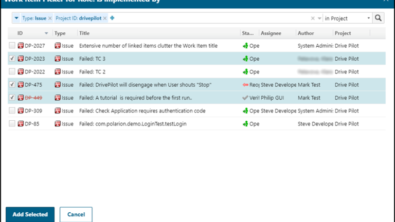
This update sounds great. A lot of eagerly awaited topics.
– Update Highchart <3
– Landscape for LiveDocs
And for 21R1 please improve the Editing of LiveDocs and Workitem descritpions
Wish: HTML Editing
Thanks, PolUser for the recognition of our team’s work!
Regarding HTML editing, this would not be a priority for us for 21 R1. However, you can already achieve the editing of the rich-text content in HTML via the developer tools in your browser. Just press F12 and edit the HTML in the browser’s editor. Sometimes it’s pretty handy to groom your pasted content this way.
Regards,
Radek Krotil
Siemens Digital Industries Software
Polarion ALM Product Management
Hello Radek,
a lot of nice enhancements, indeed!
I have one question that is important for us as we are working on medical devices business where e.g. FDA regulations are essential.
You announce the change in the electronic signature functionality. My question is: does this change affect the Polarion compliance with FDA Part 11 requirements for electronic records and especially electronic signatures.
The change note here for convenience:
Electronic signatures integrated with single sign-on authentication
Using electronic signatures together with single sign-on authentication required an additional LDAP connection to your identity provider – until now. To simplify the configuration and address limitations for cloud identity providers such as Okta, Polarion 20 R2 can leverage single sign-on authentication source to validate the signature.
Hi Pauli.
No, this change actually complements the Polarion compliance with FDA Part 11 and unlocks the e-signatures for customers leveraging SaaS identity providers. The only caveat is that the configuration of the flow of the electronic signature requires the right configuration on all the involved parts – Polarion, your identity provider, and possibly also the browser.
Best regards,
Radek Krotil
Siemens Digital Industries Software
Polarion ALM Product Management
Hello Radek,
when is the new Release 21 R1 available ? Is there an officieal release date so far ?
Regards Sven